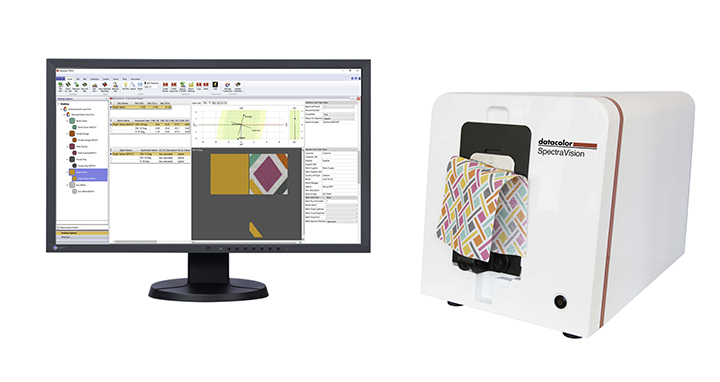While digitalization has become increasingly valuable over the past few years, the COVID-19 pandemic has emphasized the need for a fully digitalized supply chain throughout the textile and fiber industries, especially as critical business decisions must now be made quickly and remotely. A digitalized supply chain is a necessary building block in the process of making what some call “Textile 4.0” a reality. Truly, we are on the forefront of a technological revolution with innovations on the horizon driven by high-end equipment, digital software, cloud computing, sensor technologies and more.
An integral – yet often overlooked – component of this equation is digital color management. Delivering the right color in textiles and fibers is surprisingly complex, and there are many variables that must be taken into account to achieve an intended color repeatedly. Digital tools and data hubs are as important as ever in helping to guarantee accurate color every time. Today’s digital color management solutions are changing the way we analyze data and inform product decisions to meet the challenges of the moment and beyond.
Introduction to digital color management
Textile and apparel brands rely on mills scattered around the world; the production of fibers and textiles is globalized. Often, a single garment will be assembled from various pieces dyed by suppliers across the globe. Because of this, managing the production cycle and maintaining quality control throughout the supply chain can be challenging, especially without digital color management solutions in place. Furthermore, visual color evaluation can be administrative, time intensive, costly and inconsistent.
This is why real-time color data is key to driving success throughout the supply chain, regardless of location. Here is where digital color management becomes crucial. Color management equipment overcomes the shortcomings of visual analysis by objectively measuring, analyzing, communicating and assessing color. Inclusive of both the hardware and software used to measure and manage color, digital color management enables consistently accurate color measurements to be taken anywhere in the world and instantly transferred across supply chains to decision makers. The end result – there is no longer a need to rely on physical samples, which are often accompanied by costly shipping fees and can result in production delays and workflow inefficiencies.
When evaluating or implementing digital color management systems, it is important to establish the application needs, then identify the equipment and capabilities that will help meet these needs. When it comes to hardware, there are typically two types of instruments used to measure colors in textiles and fibers – colorimeters and spectrophotometers.

Colorimeters
A colorimeter is a tristimulus color measurement tool that evaluates color using red, green and blue filters to record the amount of light reflected in three wavelength ranges across the visible spectrum. Colorimeters simulate how the human eye perceives color and cannot detect metamerism (when two objects have different spectral curves and match under at least one combination of illuminant and observer, but not another). Colorimeters are typically used for color quality control and straightforward color identification. They are not suitable for calculating color formulas and not ideal for those looking to implement a completely digital workflow.
Spectrophotometers
Spectrophotometers perform full-spectrum color measurement to generate color data beyond observation by the human eye. Spectrophotometers analyze the light reflected or transmitted by a sample at each wavelength. This data represents the photometric characteristics of the sample, or spectral data, that is highly accurate and consistent. The spectral data can be used to calculate the tristimulus values of a color and can identify whether samples are metameric to each other. Spectral data can also be used to calculate accurate color recipes for color matching. Spectrophotometers offer tight color consistency and precision and are useful for those interested in implementing digital color communication.
Of course, color measurement instruments like spectrophotometers are just one piece of the digital color management puzzle in textiles and fibers. Digital color management includes any and all processes that are impacted by color, from design to production, spanning across multiple brands, suppliers and mills.
The shift to digitalization
The shift to digitalization requires the industry to rethink the current workflow for color management. Because modern color management solutions are smaller, lighter and faster than ever, implementing a digitalized workflow can be a seamless transition. The following is an example of a digital workflow and the benefits that come along with it.
A fully digital color management workflow in textiles and fibers starts at the very beginning, with measurement of design inspiration using a spectrophotometer and digital evaluation of color palettes, which allows the color team to assess colors without producing or shipping physical samples. To save time, in a digital workflow, digital color standards are communicated to suppliers, allowing them time to identify any metamerism issues and eliminate unacceptable submissions before the sample is even dyed. This is possible because of digital color data and numerical tolerances. For some, color management stops as soon as a lab dip is approved; however, costly mistakes can still happen at this point. Digital color management solutions are extremely valuable at this step in the workflow, making production quality control checks possible and giving users the ability to measure traditionally “unmeasurable” materials, such as multi-fibered yarn, patterns, loose fibers and lace through specialized hyperspectral spectrophotometers. Digitalized workflows also eliminate data silos by allowing data to be communicated and integrated seamlessly – accessible data provides for a more transparent workflow.
Digital color management has brought objectivity to an otherwise subjective process. With the textile industry under pressure to increase speed to market, the “need for speed” can be found in every part of the workflow, emphasizing the need for digital color management technology. A fully digital supply chain helps to speed up the textile development process, making it possible to make efficient product decisions at the point of manufacturing without heavy brand oversight, which ultimately increases overall speed-to-market.
With the right digital tools and solutions, a single garment made of multiple components from around the world can be produced exactly as the designer intended, while also being on time and within budget.
When evaluating or implementing digital color management systems, it is important to establish the application needs, then identify the equipment and capabilities that will help meet these needs.
Looking to the future
Over the past two decades, technology has shifted to close the gap of how data is analyzed and how critical business decisions involving color are made. This shift in technology has included the introduction of hyperspectral spectrophotometers, excellent inter-instrument agreement (IIA) in spectrophotometers, color data hubs for more efficient digital communication, lab audit programs and increased portability.
If the entire textile industry can embrace digitalization, there is endless potential in the way the industry uses and communicates data. People have recently learned that they can do their jobs differently and remotely as traditional roles are changing, which makes digitalization even more important, especially as it relates to communicating color data. For example, in the wake of COVID-19, many colorists are relying heavily on global partners, whether a regional office or vendor or mill, to ensure color quality meets their specifications. Digital color management allows colorists to monitor submissions and approvals without physically using a light box. Instead, colorists are now overseeing and managing color digitally throughout the supply chain. Managing and measuring color in an age of remote work is made possible by digital color management solutions, and those with a digitalized workflow are already positioned to meet the changing needs of the industry.
There are exciting new innovations on the horizon that will help close the gap of how color data is applied and analyzed throughout textiles and fibers. As digitalization becomes more accepted, the industry can expect to see advanced sensor technologies and cloud computing become more prevalent.
Digital color management is necessary to streamline color control of textiles and fibers. Embracing digitalization can transform the entire supply chain to match industry expectations, save time and money, lead to greater efficiency and move the industry closer to meeting the promise of “Textile 4.0.”


